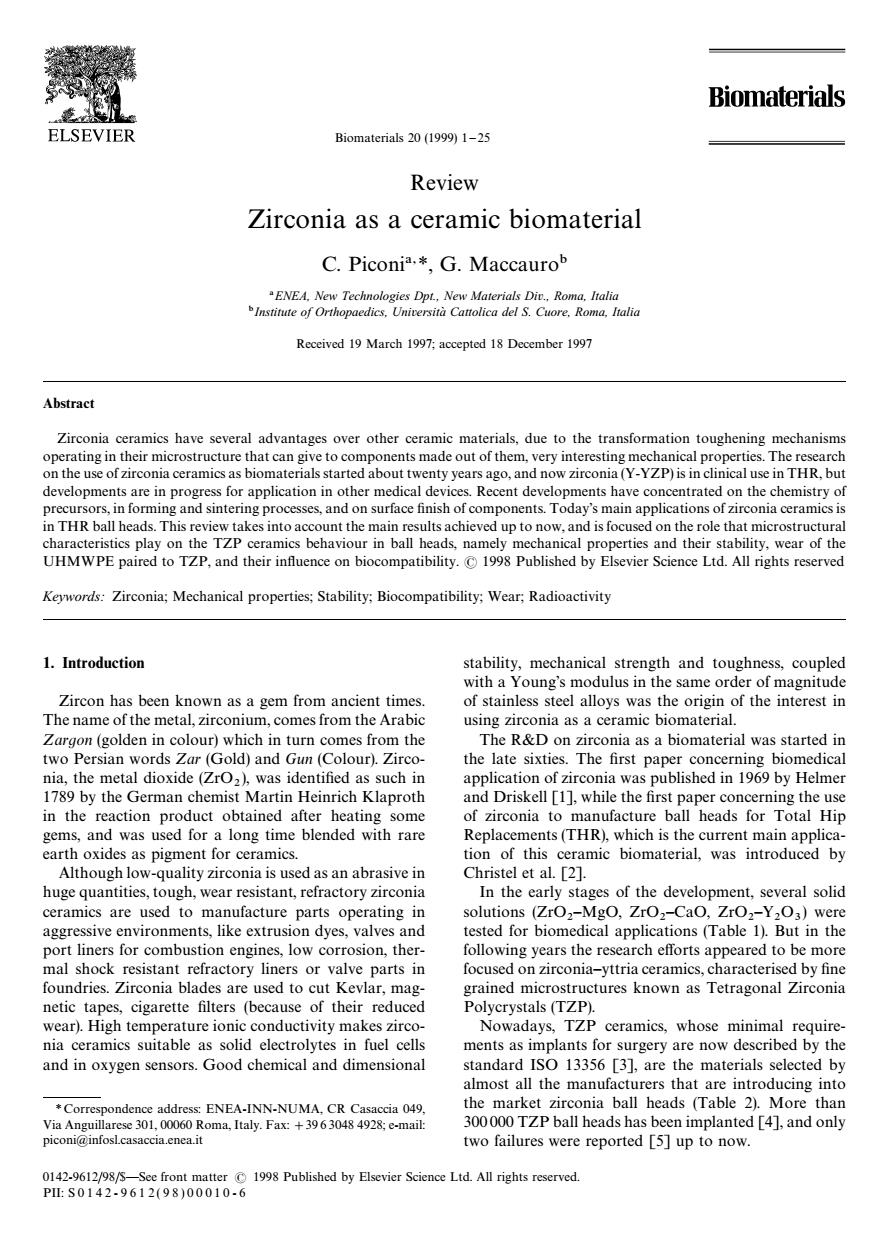正在加载图片...

变 Biomaterials ELSEVIER Biomaterials20()1-25 Review Zirconia as a ceramic biomaterial C.Piconi".*G.Maccaurob Reccived 19 March 1997:accepted 18 December 1997 Abstract Zirconia ceramics have severa advantages over other ceramic materials,due to the transformation toughening mechanism ;Mechanical properties Stability Biocompatibility Wear,Radioactivity 1.Introduction Thename te meohe Aumbe same using zirconia as a ceramic biomaterial. Zargon (golden in colour)which in turn comes from the The R&D on zirconia as a biomaterial was started in d)and Gun (Colour).Zirco in the reaction product obtained after heating some of zirconia to manufacture ball heads for Total Hip gems,and was used for a long time blended with rare or ce In the early stages of the development,several solid ceramics are used to manufacture parts operating in solutions (ZrO2-MgO,ZrO2-CaO,ZrOz-Y2O3)were aggressive environments,like extrusion dyes,valves tested for biomedical applications(Table 1).But in the for com on engines,low co ollowing years the rese d to be more foundries.Zirconia blades are used to cut Kevlar,mag netic tapes,cigarette filters (because of their reduced ia ocramics uable as solide e almost all the manufactu arers that are introducing into the market zirconia ball heads (Table 2).More than 30000 TZP ball heads has been implanted [4],and only ailures were reported [5]up to now Pabiod by eveedBiomaterials 20 (1999) 1 —25 Review Zirconia as a ceramic biomaterial C. Piconi!,*, G. Maccauro" !ENEA, New Technologies Dpt., New Materials Div., Roma, Italia "Institute of Orthopaedics, Universita` Cattolica del S. Cuore, Roma, Italia Received 19 March 1997; accepted 18 December 1997 Abstract Zirconia ceramics have several advantages over other ceramic materials, due to the transformation toughening mechanisms operating in their microstructure that can give to components made out of them, very interesting mechanical properties. The research on the use of zirconia ceramics as biomaterials started about twenty years ago, and now zirconia (Y-YZP) is in clinical use in THR, but developments are in progress for application in other medical devices. Recent developments have concentrated on the chemistry of precursors, in forming and sintering processes, and on surface finish of components. Today’s main applications of zirconia ceramics is in THR ball heads. This review takes into account the main results achieved up to now, and is focused on the role that microstructural characteristics play on the TZP ceramics behaviour in ball heads, namely mechanical properties and their stability, wear of the UHMWPE paired to TZP, and their influence on biocompatibility. ( 1998 Published by Elsevier Science Ltd. All rights reserved Keywords: Zirconia; Mechanical properties; Stability; Biocompatibility; Wear; Radioactivity 1. Introduction Zircon has been known as a gem from ancient times. The name of the metal, zirconium, comes from the Arabic Zargon (golden in colour) which in turn comes from the two Persian words Zar (Gold) and Gun (Colour). Zirconia, the metal dioxide (ZrO2 ), was identified as such in 1789 by the German chemist Martin Heinrich Klaproth in the reaction product obtained after heating some gems, and was used for a long time blended with rare earth oxides as pigment for ceramics. Although low-quality zirconia is used as an abrasive in huge quantities, tough, wear resistant, refractory zirconia ceramics are used to manufacture parts operating in aggressive environments, like extrusion dyes, valves and port liners for combustion engines, low corrosion, thermal shock resistant refractory liners or valve parts in foundries. Zirconia blades are used to cut Kevlar, magnetic tapes, cigarette filters (because of their reduced wear). High temperature ionic conductivity makes zirconia ceramics suitable as solid electrolytes in fuel cells and in oxygen sensors. Good chemical and dimensional * Correspondence address: ENEA-INN-NUMA, CR Casaccia 049, Via Anguillarese 301, 00060 Roma, Italy. Fax:#39 6 3048 4928; e-mail: piconi@infosl.casaccia.enea.it stability, mechanical strength and toughness, coupled with a Young’s modulus in the same order of magnitude of stainless steel alloys was the origin of the interest in using zirconia as a ceramic biomaterial. The R&D on zirconia as a biomaterial was started in the late sixties. The first paper concerning biomedical application of zirconia was published in 1969 by Helmer and Driskell [1], while the first paper concerning the use of zirconia to manufacture ball heads for Total Hip Replacements (THR), which is the current main application of this ceramic biomaterial, was introduced by Christel et al. [2]. In the early stages of the development, several solid solutions (ZrO2 —MgO, ZrO2 —CaO, ZrO2 —Y2 O3 ) were tested for biomedical applications (Table 1). But in the following years the research efforts appeared to be more focused on zirconia—yttria ceramics, characterised by fine grained microstructures known as Tetragonal Zirconia Polycrystals (TZP). Nowadays, TZP ceramics, whose minimal requirements as implants for surgery are now described by the standard ISO 13356 [3], are the materials selected by almost all the manufacturers that are introducing into the market zirconia ball heads (Table 2). More than 300 000 TZP ball heads has been implanted [4], and only two failures were reported [5] up to now. 0142-9612/98/$—See front matter ( 1998 Published by Elsevier Science Ltd. All rights reserved. PII: S 0 1 4 2 - 9 6 1 2 ( 9 8 ) 0 0 0 1 0 - 6